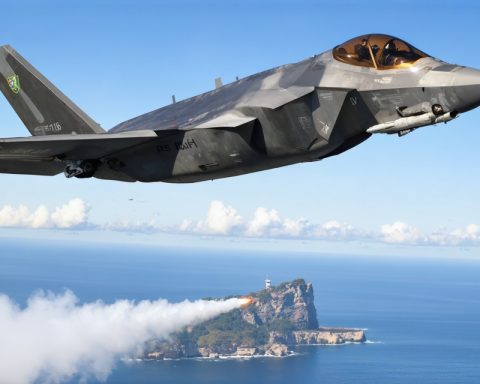- Russian MiG-25 Foxbat and MiG-31 Foxhound showcase extreme speed and Cold War-era engineering, reaching Mach 3.2 and Mach 2.83, respectively.
- MiG-31 continues to serve Russia and Kazakhstan, exemplifying strategic reconnaissance capabilities despite radar vulnerabilities.
- The U.S. F-15 Eagle, achieving Mach 2.5, combines speed with unmatched aerial combat finesse, with widespread use by multiple countries, including the U.S., Israel, and Japan.
- The Russian Su-27 Flanker demonstrates versatility and resilience, achieving Mach 2.35 and serving countries like Ukraine.
- The MiG-23 Flogger, a Mach 2.35 aircraft with a distinctive wing design, remains in service by nations like North Korea and Libya.
- These legendary fighter jets emphasize speed’s importance in air dominance, prompting speculation on the future role of speed versus stealth in aviation.
The ever-evolving dance between technological innovation and aerial supremacy is a mesmerizing spectacle. As nations vie for dominance in the skies, a select cohort of fighter jets continues to capture imaginations with their breakneck speeds and captivating histories. Leading this skyward marvel is the venerable Russian MiG-25 Foxbat, a fearsome relic of Cold War ambition that can blaze across the horizon at a jaw-dropping Mach 3.2, or approximately 2,200 miles per hour, challenging its pilots and engineers alike with its extreme power.
Little brother to the Foxbat, the MiG-31 Foxhound upholds the family tradition with a lofty Mach 2.83, preserving Russia’s tenacity in maintaining aerial proficiency at the edge of Earth’s atmosphere. Despite its age, this aircraft excels at altitude, offering advantages in strategic reconnaissance alongside its blistering speed. Serving today in Russia and Kazakhstan, the Foxhound is a testimony to enduring technological legacy, despite its visibility disadvantage in the radar-dominated battlefield.
The United States enters the fray with its celebrated F-15 Eagle series, hawkishly defending its place among the fastest with speeds reaching Mach 2.5. Unlike its Russian counterparts, the F-15 distinguishes itself with an unrivaled mastery in aerial combat finesse, blending agility with raw speed. This remarkable craft is not merely a pursuit vehicle; it is a revered dogfighter admired for its battle-proven record of aerial victories. Held aloft by the U.S., Israel, Japan, and Saudi Arabia, its legacy is poised to continue with the upcoming F-15EX.
The Russian Su-27 Flanker further punctuates the competition with a versatile design achieving Mach 2.35. Known for its impressive range and adaptability, the Flanker remains a backbone of aerial combat—engineered to match American ingenuity stride for stride. Deployed in active service by Ukraine as well, this combatant has fulfilled various roles, adapting to each new era it encounters.
Rounding out this elite circle is the MiG-23 Flogger, embodying the marriage of vintage allure and sustained relevance. Having taken flight over half a century ago, this Mach 2.35 jet boasts a variable-sweep wing design that once signaled its advanced technological prowess. Although it is a third-generation aircraft, the Flogger remains in service across a myriad of nations, from North Korea to Libya, Cuba to Syria—each flight a testament to its enduring reliability and charm.
The fierce winds of change blow constantly through the aerospace industry. Today, these extraordinary machines serve as reminders of speed’s fundamental role in asserting control over the skies. Yet as nations look to the horizon, the question remains: Will the era of blazing speed continue to define air supremacy, or will stealth and technological complexity write the next chapter in aviation history? As eyes turn to future projects like Russia’s proposed MiG-41, the race once more gains momentum—speeding toward the promise of Mach 4 capability.
The Hidden Power of Supersonic Fighter Jets: Beyond Speed and Majesty
The world of fighter jets is a thrilling testament to human ingenuity and engineering prowess. Beyond the eye-watering speeds of legendary aircraft like the MiG-25 Foxbat and F-15 Eagle lies a complex interplay of technology, strategy, and speculative advancements. While speed remains a key attribute, technological evolution is increasingly focusing on other factors such as stealth, versatility, and intelligence. Let’s explore these exhilarating machines and uncover the nuanced realities of contemporary and future aerial warfare.
Unveiling the Unexplored Facts
1. Advanced Avionics and Radar Systems:
Modern fighter jets are equipped with advanced avionics that provide real-time data, enhancing situational awareness. For instance, the F-15 Eagle is lauded for its APG-63 radar system, which allows it to track multiple targets over 100 miles away, a significant advantage in combat scenarios.
2. The Role of Stealth Technology:
While speed is crucial, stealth technology is becoming increasingly important. The U.S. has pioneered developments here, with aircraft like the F-22 Raptor and F-35 Lightning II designed to evade enemy radar detection, representing a shift towards stealth supplanting raw speed.
3. Multi-Role Capabilities:
Many modern fighters, such as the Russian Su-27 Flanker, are versatile enough to fill various combat roles, from air superiority to ground attack missions. This flexibility allows countries to reduce the need for specialized aircraft, lowering costs and enhancing strategic capabilities.
4. Future of Speed and Aerial Combat:
The anticipated MiG-41, a successor to the MiG-31 Foxhound, aims to achieve speeds of Mach 4. Alas, with advancements that include advanced weaponry and autonomous capabilities, this jet symbolizes the future of air superiority.
How to Measure Success in Modern Fighter Jets
– Evaluate Technological Integration: When assessing a fighter jet’s capabilities, consider its integration of new technologies, especially in avionics, radar, and stealth.
– Understanding Roles: Recognize the aircraft’s versatility and ability to adapt to different mission profiles to decide its strategic value.
Real-World Use Cases and Market Trends
1. Operational Readiness and Deployment:
Countries like Russia and the U.S. maintain elaborate infrastructure for rapid response, showcasing the ongoing imperative of speed in military doctrine.
2. Global Market Trends:
There is an increasing shift towards unmanned aerial vehicles (UAVs) and drones, but manned fighter jets still dominate due to their speed and payload capabilities.
Reviews and Comparisons
Pros and Cons Overview
– MiG-25 Foxbat:
– Pros: Extreme speed and ceiling, strategic reconnaissance capabilities.
– Cons: Higher radar visibility, less maneuverable.
– F-15 Eagle:
– Pros: Exceptional combat record, versatile, superior avionics.
– Cons: High operational costs, larger radar cross-section compared to newer stealth fighters.
– Su-27 Flanker:
– Pros: Versatile, excellent maneuverability, robust design.
– Cons: Aging airframe, challenged by contemporary radar systems.
Controversies and Limitations
– Environmental Impact and Sustainability:
Speed-centric aircraft often have higher fuel consumption, leading to increased emissions and environmental impact. Efforts are ongoing to make future jets more eco-friendly.
– Security Concerns:
As these machines become more technologically advanced, cybersecurity becomes a critical concern, safeguarding sensitive data and mission integrity.
Insights and Predictions
Looking ahead, the focus on hypersonic speeds, AI integration, and enhanced sustainability will reshape the fighter jet landscape. Nations are investing heavily in research and development, responding to geopolitical pressures and technological challenges.
Actionable Recommendations
1. Prioritize Innovation: Countries should foster innovation by investing in R&D focused on stealth, AI, and sustainable technologies.
2. Enhance Training Programs: Advanced training simulators and real-world exercises should be integrated to optimize pilots’ proficiency in handling these sophisticated aircraft.
3. Collaborate on International Frameworks: Global cooperation on regulatory and environmental standards can help mitigate the impact of military aviation on climate change.
Relevant Links
– Visit the Lockheed Martin website for insights into cutting-edge stealth technology in aviation.
– Explore future aviation trends at Boeing.
These insights underscore the thrilling dance of speed and innovation that defines modern aerial supremacy, urging us all to keep an eye on the horizon for the next leap in aviation technology.









